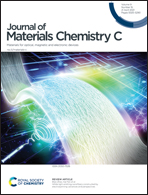Copper-doped α-MnO2 nano-sphere: metamaterial for enhanced supercapacitor and microwave shielding applications†
Abstract
α-MnO2 nanoparticles with increasing copper-doping concentration have been synthesized through a modified hydrothermal technique. Doping-induced microstructural defects inside the host material lead to a giant dielectric constant 1.6 × 106 with moderate tangent loss at 20 Hz frequency. In the microwave frequency region, synthesized nanoparticles showed a dual loss mechanism which includes valuable dielectric and magnetic loss of the order of ∼0.45. Consequently, this dual loss mechanism leads to strong electromagnetic interference (EMI) shielding effectiveness (SE) of ∼−38 dB at 14 GHz and −49 dB at 17.5 GHz for 15 wt% of Cu doped α-MnO2 thin layer of thickness ∼600 μm. This result reveals >99.999% EMI SE against hazardous electromagnetic waves in the microwave/GHz frequency region. Additionally, cyclic voltammetry and galvanostatic charge–discharge measurements in the potential range of −0.4 V to +0.2 V demonstrate an enhanced capacitance value of 334.2 F g−1 at a current density of 0.5 A g−1 with 96% charge retentivity up to the 2000th cycle. Finally, a solid-state supercapacitor device was fabricated which could light up 2 red LEDs for 10 s.



 Please wait while we load your content...
Please wait while we load your content...